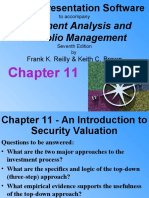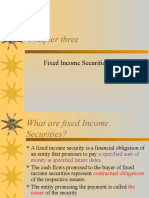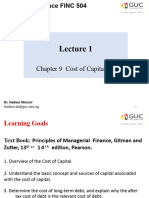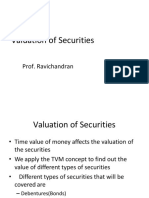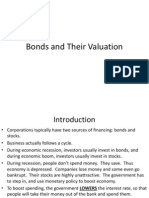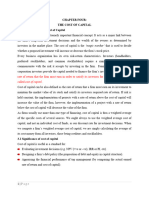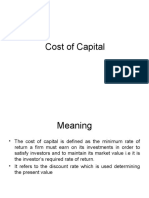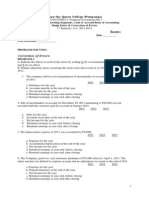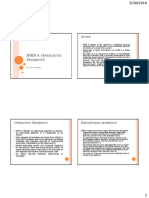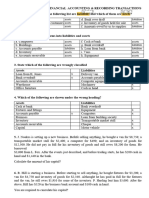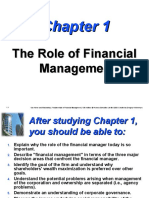Chapter 4: The Valuation of Long-Term Securities: - Study Objectives
Chapter 4: The Valuation of Long-Term Securities: - Study Objectives
Uploaded by
Usman FazalCopyright:
Available Formats
Chapter 4: The Valuation of Long-Term Securities: - Study Objectives
Chapter 4: The Valuation of Long-Term Securities: - Study Objectives
Uploaded by
Usman FazalOriginal Title
Copyright
Available Formats
Share this document
Did you find this document useful?
Is this content inappropriate?
Copyright:
Available Formats
Chapter 4: The Valuation of Long-Term Securities: - Study Objectives
Chapter 4: The Valuation of Long-Term Securities: - Study Objectives
Uploaded by
Usman FazalCopyright:
Available Formats
Chapter 4: The valuation of long-term securities
Study objectives Distinctions among valuation concepts Bond valuation Preferred stock valuation Common stock valuation Rates of Return Why shall we know the valuation of long-term securities? Make investment decisions Determine the value of the firm Distinctions among valuation concepts (1)Liquidation value versus going-concern value Liquidation value is the amount of money that could be realized if an asset or a group of assets (e.g., a firm) is sold separately from its operating organization. Going-concern value is the amount a firm could be sold for as a continuing operating business The computation of liquidation value and going-concern value is very different As in accounting, the security valuation models that we will discuss in this chapter will generally assume that we are dealing with going-concern (2)Book value versus market value The book value of an asset is the accounting value of the asset---the assets cost minus its accumulated depreciation. The book value of a firm is equal the dollar difference between the firms total assets and its liabilities and preferred stock as listed on its balance sheet Because book value is based on historic values and estimations, it may not be accurate after a long period of time In general, the market value of an asset is simply the market price at which the asset (or a similar asset) trades in an open market place. For a firm, market value often viewed as being the higher of the firms liquidation or going concern value Market value often outrival book value as to decision relevance, because market value takes risk, future opportunity, current cash flow in account. Market value versus intrinsic value For an actively traded security, the market value would be the last reported price at which the security was traded. For an inactively traded security, an estimated market price would be needed The intrinsic value of a security is what the price of a security should be if properly priced based on all factors bearing on valuation---assets, earnings, future prospects, management, and so on. If markets are reasonably efficient and informed, the current market price of a security should fluctuate closely around its intrinsic value The valuation approach The valuation approach taken in this chapter is one of determining a securitys intrinsic value. This value is the present value of the cash flow stream provided to the investor, discounted at a required rate of return appropriate for the risk involved Bond valuation
A bond is a security that pays a stated amount of interest to the investor, period after period, until it is finally retired by the issuing company In China, bond interest may not be paid annually, but until the retirement of the bond Face value is the stated value of an asset. In the case of a bond, the face value is usually $1000 The face value is supposed to be paid back to the bondholders as the principal, no matter what the purchasing price of the bond Coupon rate: the stated rate of interest on a bond; the annual interest payment divided by bonds face value The factors that affect the valuation of bond Face value Coupon rate Required rate of return Maturity (1)The Model of Bond Valuation Perpetual Bonds A bond that never matures (rarely exists now) Bonds with a Finite Maturity Typical coupon bonds (limited outstanding period, annually paid interest) V=I(PVIFAr,n)+MV(PVIFr,n) Example The Brothers determines to issue 10000 $1000-par-value bonds with 10% coupons. The bonds will be retired in 9 years. The Brothers decides to issue the bond at $1020. If Mr. White wants to buy the bond and his required rate of return is 8%, should Mr. White buy the bond? V=$100(PVIFA8%,9)+$1000(PVIF8%,9)=$1124.70 Because V>P, Mr. White should buy the bond Zero-coupon bond A zero-coupon bond is a bond that pays no interest but sells at a deep discount from its face value; it provides compensation to investors in the form of price appreciation The interest of a zero-coupon bond is the remainder of the face value less issuing price V=MV/(1+r)n Example Suppose that Pace Enterprises issues a zero-coupon bond having a 10-year maturity and a $1000 face value. If the investors required return is 12%, then V=$1000/(1+12%)10=$322 Seminal compounding of interest Although some bonds (typically those issued in European Markets) make interest payments once a year, most bonds issued in America pay interest twice a year. As a result, it is necessary to modify our bond valuation model V=(I/2)(PVIFAr/2,2n)+MV(PVIFr/2,2n), here I is the nominal interest of the bond and n is the years that the bond exists To illustrate, if the 10% coupon bonds of the U.S. Blivet Corporation have 12 years to maturity and our nominal annual required rate of return is 14%, the value of one $1000-par-value bond is V=($50/2)(PVIFA14/2,24)+MV(PVIF14/2,24)=$770.45 Why V<par value? Because required return>coupon rate
Preferred Stock Valuation Preferred stock is a type of stock that promises a (usually) fixed dividend, but at the discretion of the directors. It has preference over common stock in the payment of dividends and claims on assets Cumulative and noncumulative preferred stock A cumulative preferred stock is a stock whose dividend not paid out is deferred to later years The payment of preferred stock is similar to an annuity, so the valuation model of a preferred stock is : Vp=Dp/R If Margana Cipher Corporation had a 9%, $100-par-value preferred stock issue outstanding and your required return was 14% on this investment, its value per share to you would be Vp=Dp/R=$64.29 In China, no listed company has issued preferred stock Common stock valuation Common stock is the security that represent the ultimate ownership (and risk) position in a corporation The difficult issues of valuation: uncertainty and payment of stock dividend, different risk levels, etc Case 1: hold the stock for a long time
D2 V = (1D1r ) + (1+r ) 2 +... +
Dn (1+ ) r
n
Dt =1+r )t ( t= 1
Case 2: hold the stock for a short time (e.g., 2 years) Note: D1, D2Dn and P2 are all estimates A logical question to the models The logical question to raise at this time is: why do the stocks of companies that pay no dividends have positive, often quite high, values? The answer is: investors expect to sell the stock in the future at a price higher than they paid for it. Terminal value depends on the expectations of the marketplace viewed from the terminal point. The ultimate expectation is that the firm will eventually pay dividends, either regular or liquidating, and that future investors will receive a company-provided cash return on their investment case 3: Constant Growth Assume that dividends grow at a constant rate. But in real life, few companies do this. We shall learn this in corporate finance---dividend policy Assume that D0 is the present dividend per share and g is the growth rate of dividend, so D 1 is (1+g) D0 , D2 is D0 (1+g)2,Dn is D0 (1+g)n According to the valuation model, constant growth stock is valuated as: Tip: a common mistake made in using the above equation is to use, incorrectly, the firms most recent annual dividend for the variable D1 instead of the annual dividend expected by the end of the coming year
g can never be larger than r, why? Suppose that LKN, Inc.s dividend per share at t=1 is expected to be $4, that it is expected to grow at a 6% rate forever, and that the appropriate discount rate is 14%. The value of one share of LKN stock would be V=$4/(0.14-0.06)=$50 Conversion to an earnings multiplier approach Assume that a company retains a constant proportion of its earnings each year; call it b, then (1b)=D1/E1, D1=E1(1-b), V=(1-b)E1/(r-g), V/E1=(1-b)/(r-g), (1-b)/(r-g) is called earnings multiplier (EM). V=E1(EM) Why we should know earnings multiplier? Because it bring together value and earnings of a stock No Growth Assume that dividends will be maintained at their current level forever ( a kind of dividend policy) V=D1/r==D0/r. like a preferred stock Growth phases Firms may exhibit above-normal growth for a number of years (g may even be larger than r during this phase), but eventually the growth rate will taper off. Assume that dividends per share are expected to grow at f compound rate for m years and thereafter at g, the valuation model is: Example If dividends per share are expected to grow at 10% compound rate for 5 years and thereafter at 6%, the required rate is 14%, how to value the stock?
t= 1
$2 (1.10 ) t (1.14 ) t
= $8.99
Rates of Return If we replace intrinsic value in our valuation equations with the market price (p0) of the security, we can then solve for the market required rate of return. This rate, which sets the discounted value of the expected cash inflows equal to the securitys current market price, is also referred to as the securitys market yield It is important to recognize that only when the intrinsic value of a security to an investor equals the securitys market value (price) would the investors required rate of return equal the securitys (market) yield Market yields serve an essential function by allowing us to compare, on a uniform basis, securities that differ in cash flow provided, maturities, and current prices Yield to maturity (YTM) on bonds Yield to maturity (YTM) is the expected rate of return on a bond if bought at its current market price and held to maturity; it is also known as the bonds internal rate of return (IRR) Mathematically, it is the discount rate that equates the present value of all expected interest payments and the payment of principal (face value) at maturity with the bonds current market price The difficult issue is: it is not a linear function, more complex
I P0 = (1+YTM t= 1 n )t M V + (1+YMT )n
Interpolation---Example Consider a $1000-par-value bond with the following characteristics: a current market price of $761; 12 years until maturity, and 8% coupon rate (with interest paid annually) Suppose we start with a 10% discount rate and calculate the present value of the bonds expected future cash flows. V=$80(PVIFA10%.12)+$1000(PVIF10%.12)=$684.12>761, so YTM>10% Try a 15% discount rate V=$80(PVIFA15%.12)+$1000(PVIF15%.12)=$620.68<761, so YTM<15% X/0.05=(864.12-761)/(864.12-620.68) X=0.0212 YTM=X+10%=12.12% It is important to keep in mind that interpolation gives only an approximation of the exact percentage; the relationship between the two discount rate is not linear with respect to present value Behavior of bond price When the market required rate of return is more than the stated coupon rate, the price of the bond will be less than its face value---bond discount When the market required rate of return is less than the stated coupon rate, the price of the bond will be more than its face value---bond premium When the market required rate of return equals the stated coupon rate, the price of the bond will equal its face value---selling at par If interest rates rise so that the market required rate of return increases, the bonds price will fall. If interest rates fall, the bonds price will increase For a given change in market required return, the price of a bond will change by a greater amount, the longer its maturity Bond price volatility is inversely related to coupon rate Figure 4-1 relation between bond price and market required rate of return YTM and Semiannual Compounding (2)Yield on preferred stock and common stock P0=Dp/r P0=D1/(r-g)
You might also like
- Midterm ReviewDocument40 pagesMidterm ReviewVanessa BatallaNo ratings yet
- About Financial Accounting - Volume 1 by F. Doussy, R.N. Ngcobo, Rehwinkel, D Scheepers, D ScottDocument401 pagesAbout Financial Accounting - Volume 1 by F. Doussy, R.N. Ngcobo, Rehwinkel, D Scheepers, D ScottRegs Accex100% (4)
- Smart Sheep and Goat Fattening Farm Enterprise: Busines S PlanDocument19 pagesSmart Sheep and Goat Fattening Farm Enterprise: Busines S PlanAbel Zegeye100% (4)
- Chapter 4 Valuation of Bonds and Cost of CspitalDocument24 pagesChapter 4 Valuation of Bonds and Cost of Cspitalanteneh hailie100% (8)
- Chapter 7a - Bonds ValuationDocument22 pagesChapter 7a - Bonds ValuationAian Cortez100% (1)
- Valuation of Financial Assets Stocks (Equity) : Business Finance 1Document23 pagesValuation of Financial Assets Stocks (Equity) : Business Finance 1Fahad NaeemNo ratings yet
- COFIA3-22 - 2024 - Week 3 - ValuationsDocument34 pagesCOFIA3-22 - 2024 - Week 3 - ValuationsbiggoboziNo ratings yet
- Investment Analysis and Portfolio Management: Frank K. Reilly & Keith C. BrownDocument122 pagesInvestment Analysis and Portfolio Management: Frank K. Reilly & Keith C. BrownWhy you want to know100% (1)
- Unit-3 4. Equity Valuation ModelsDocument46 pagesUnit-3 4. Equity Valuation ModelsJack SparrowNo ratings yet
- 11 - Chapter 4 The Valuation of Long-Term SecuritiesDocument53 pages11 - Chapter 4 The Valuation of Long-Term SecuritiesIni Ichiii100% (1)
- Chapter Two: Financing Decisions / Capital StructureDocument72 pagesChapter Two: Financing Decisions / Capital StructureMikias DegwaleNo ratings yet
- 11.1 Risk-Adjusted Expected Rates of ReturnDocument19 pages11.1 Risk-Adjusted Expected Rates of Returndennisemonreal00No ratings yet
- Cost of Capital Further DetailDocument57 pagesCost of Capital Further Detaildeigcorr22No ratings yet
- Valuation of Financial AssetsDocument39 pagesValuation of Financial Assetspartha_biswas_uiuNo ratings yet
- Valuation of Securities: by - ) Ajay Rana, Sonam Gupta, Shivani, Gurpreet, ShilpaDocument46 pagesValuation of Securities: by - ) Ajay Rana, Sonam Gupta, Shivani, Gurpreet, ShilpaTanmoy ChakrabortyNo ratings yet
- Investment Analysis and Portfolio Management: Frank K. Reilly & Keith C. BrownDocument118 pagesInvestment Analysis and Portfolio Management: Frank K. Reilly & Keith C. BrownseptaritaNo ratings yet
- Lecture 3-Bond ValuationDocument16 pagesLecture 3-Bond Valuationjamesronaldo1111No ratings yet
- Chap 3 Fixed Income SecuritiesDocument45 pagesChap 3 Fixed Income SecuritiesHABTAMU TULU0% (1)
- Objective of A FirmDocument35 pagesObjective of A FirmShibin PaulNo ratings yet
- Lecture 1Document29 pagesLecture 1nourkhaled1218No ratings yet
- CH 9 - Business Valuation - Part 1Document7 pagesCH 9 - Business Valuation - Part 1Hazrat BilalNo ratings yet
- Share ValuationDocument52 pagesShare ValuationMinato UzumakiNo ratings yet
- FM Ch14 Ross 20206793718140352300766Document81 pagesFM Ch14 Ross 20206793718140352300766စိုးမင္း ထြန္းNo ratings yet
- Security Valuation: Bond, Equity and Preferred StockDocument40 pagesSecurity Valuation: Bond, Equity and Preferred StockMohamed KoneNo ratings yet
- Sesi 5 Valuasi ObligasiDocument17 pagesSesi 5 Valuasi ObligasigalihNo ratings yet
- Valuation and Rates of Return: Mcgraw-Hill/IrwinDocument11 pagesValuation and Rates of Return: Mcgraw-Hill/IrwinAhmed ShantoNo ratings yet
- Cost of Preference CapitalDocument10 pagesCost of Preference CapitalnanidoppiNo ratings yet
- CH 4 - Fixed Income SecurityDocument49 pagesCH 4 - Fixed Income SecurityALEMU TADESSENo ratings yet
- Valuation of Bonds and SharesDocument42 pagesValuation of Bonds and SharesTanvir IslamNo ratings yet
- Cost of Capital PDFDocument44 pagesCost of Capital PDFAditya ShresthaNo ratings yet
- Chapter 2 Fixed Income SecuritiesDocument18 pagesChapter 2 Fixed Income SecuritiesGeremew MetadelNo ratings yet
- Ch11-Valuation of SecuritiesDocument94 pagesCh11-Valuation of SecuritiesRaiHan AbeDinNo ratings yet
- Bonds ValuationDocument3 pagesBonds ValuationJeremie RussNo ratings yet
- Valuing Residual Cash FlowDocument43 pagesValuing Residual Cash FlowEssue KediaNo ratings yet
- Cost of Capital: Dr. A.N. SAHDocument41 pagesCost of Capital: Dr. A.N. SAHHARMANDEEP SINGHNo ratings yet
- Chapter 7 Cost of CapitalDocument38 pagesChapter 7 Cost of CapitalJonathan JibuNo ratings yet
- Chapter - Four: Bond and Stock Valuation and The Cost of CapitalDocument10 pagesChapter - Four: Bond and Stock Valuation and The Cost of CapitalWiz Santa0% (1)
- Valuation of SecuritiesDocument43 pagesValuation of SecuritiesVaidyanathan Ravichandran100% (1)
- Chapter-17Document9 pagesChapter-17Saif AhamedNo ratings yet
- Bonds and Their ValuationDocument41 pagesBonds and Their ValuationRenz Ian DeeNo ratings yet
- Chapter 10 - TheoryDocument9 pagesChapter 10 - TheoryKazi Khalid HossainNo ratings yet
- Cavendish University Uganda: Mba715 Finance For Managers SATURDAY at 2:30-5:30PMDocument53 pagesCavendish University Uganda: Mba715 Finance For Managers SATURDAY at 2:30-5:30PMFaith AmbNo ratings yet
- Chapter Four FMDocument7 pagesChapter Four FMHope GoNo ratings yet
- Fm-I Chap-V EditedDocument30 pagesFm-I Chap-V Editedtibebu5420No ratings yet
- Corporate BondsDocument36 pagesCorporate BondsCharlene LeynesNo ratings yet
- Chapter 10Document8 pagesChapter 10Hareem Zoya WarsiNo ratings yet
- Topic 6 WACCDocument43 pagesTopic 6 WACCsimfukwepascal812No ratings yet
- Lecture 3 - Valuing BondsDocument23 pagesLecture 3 - Valuing Bondsannalenas2000No ratings yet
- ValuationDocument23 pagesValuationBisma KhalidNo ratings yet
- Bonds CH08Document16 pagesBonds CH08Hendrickson Cruz SaludNo ratings yet
- Chapter Four: The Cost of Capital 4.1. The Concept of Cost of CapitalDocument9 pagesChapter Four: The Cost of Capital 4.1. The Concept of Cost of Capitalmelat felekeNo ratings yet
- Factors Affecting Cost of CapitalDocument40 pagesFactors Affecting Cost of CapitalKartik AroraNo ratings yet
- 04 The Value of Common StockDocument27 pages04 The Value of Common Stockmelekkbass10No ratings yet
- Corp FinDocument45 pagesCorp FinSoe Group 1No ratings yet
- Chapter 5 FM IDocument45 pagesChapter 5 FM Isisaytek69No ratings yet
- Valuation Concepts & ModelsDocument18 pagesValuation Concepts & Modelssmwanginet7No ratings yet
- FN1024 Chapter 7 PDF RevDocument34 pagesFN1024 Chapter 7 PDF Revduong duongNo ratings yet
- Cost of Capital and Capital StructureDocument40 pagesCost of Capital and Capital StructureJames NgonyaniNo ratings yet
- Lecture 3B Bonds Capital Markets. Pricing, Yield For Coupon Paying BondsDocument23 pagesLecture 3B Bonds Capital Markets. Pricing, Yield For Coupon Paying BondsdishaparmarNo ratings yet
- Cost of Capital, CH 14Document39 pagesCost of Capital, CH 14202110782No ratings yet
- Valuation - 1st LectureDocument10 pagesValuation - 1st LecturesunjayhoonNo ratings yet
- Fixed Income Securities: A Beginner's Guide to Understand, Invest and Evaluate Fixed Income Securities: Investment series, #2From EverandFixed Income Securities: A Beginner's Guide to Understand, Invest and Evaluate Fixed Income Securities: Investment series, #2No ratings yet
- MQC - Quiz On Segment, Cash To Accrual, Single and CorrectionDocument10 pagesMQC - Quiz On Segment, Cash To Accrual, Single and CorrectionLenie Lyn Pasion Torres0% (1)
- Value For Money. Basically, It Means Applying: Notes in Financial ManagementDocument6 pagesValue For Money. Basically, It Means Applying: Notes in Financial ManagementKristine PerezNo ratings yet
- Working Capital Management and Its Impact On The Profitability of Pukar International Co - LTDDocument7 pagesWorking Capital Management and Its Impact On The Profitability of Pukar International Co - LTDcalamnojeffrey29No ratings yet
- Lease Accounting in SAPDocument29 pagesLease Accounting in SAPMalcolm TangNo ratings yet
- ProductivityDocument6 pagesProductivityMallikarjun ReddyNo ratings yet
- Greenwald Class Notes 5 - Liz Claiborne & Valuing GrowthDocument17 pagesGreenwald Class Notes 5 - Liz Claiborne & Valuing GrowthJohn Aldridge Chew100% (2)
- Resunga Multiple Campus: Resunga Municipality, Gulmi Internal Examination - 2079Document2 pagesResunga Multiple Campus: Resunga Municipality, Gulmi Internal Examination - 2079KAMAL POKHRELNo ratings yet
- Ifrs 8Document3 pagesIfrs 8Samantha IslamNo ratings yet
- Effects of Cash Management Practice On Financial Performance of Las Pinas Florita Trading 2Document82 pagesEffects of Cash Management Practice On Financial Performance of Las Pinas Florita Trading 2Rubie Grace ManaigNo ratings yet
- Chap 019Document36 pagesChap 019skuad_024216No ratings yet
- Latest Development of IFRS (and HKFRS) : Nelson Lam Nelson Lam 林智遠 林智遠Document32 pagesLatest Development of IFRS (and HKFRS) : Nelson Lam Nelson Lam 林智遠 林智遠ChanNo ratings yet
- Dube Clarance T.Document80 pagesDube Clarance T.Gerald TimbaNo ratings yet
- ZuariDocument62 pagesZuariAnnapurna VinjamuriNo ratings yet
- Hatsun Agro KarvyDocument13 pagesHatsun Agro Karvyarif420_999No ratings yet
- BAMA 1101, CH5, DepreciationDocument26 pagesBAMA 1101, CH5, DepreciationWijdan Saleem EdwanNo ratings yet
- Assessing A New Venture's Financial Strength and ViabilityDocument6 pagesAssessing A New Venture's Financial Strength and ViabilityAsif KureishiNo ratings yet
- 1 - ExercisesDocument6 pages1 - ExercisesTrang Nguyễn QuỳnhNo ratings yet
- Project Report On AVALON COSMATICDocument78 pagesProject Report On AVALON COSMATICsantosh0% (2)
- Njoki BPDocument24 pagesNjoki BPyegonf412No ratings yet
- Bussiness PlanDocument15 pagesBussiness PlanMatty BNo ratings yet
- CHP 6 Internal ReconstructionDocument60 pagesCHP 6 Internal ReconstructionRonak ChhabriaNo ratings yet
- P2Document8 pagesP2Kristin Zoe Newtonxii Paez0% (1)
- Controlling and Costing Materials Inventory - Module On Cost AccountingDocument3 pagesControlling and Costing Materials Inventory - Module On Cost Accountinggeneral useNo ratings yet
- Hca14 IM CH23 GE PDFDocument15 pagesHca14 IM CH23 GE PDFLidwina EdithyaningtyasNo ratings yet
- CFR ProblemsDocument28 pagesCFR ProblemsMadhu kumarNo ratings yet
- The Role of Financial Management The Role of Financial ManagementDocument24 pagesThe Role of Financial Management The Role of Financial ManagementMuhammad Usama IqbalNo ratings yet
- Acct101 Practice Exam Chapters 1 and 2Document15 pagesAcct101 Practice Exam Chapters 1 and 2leoeoa100% (2)















